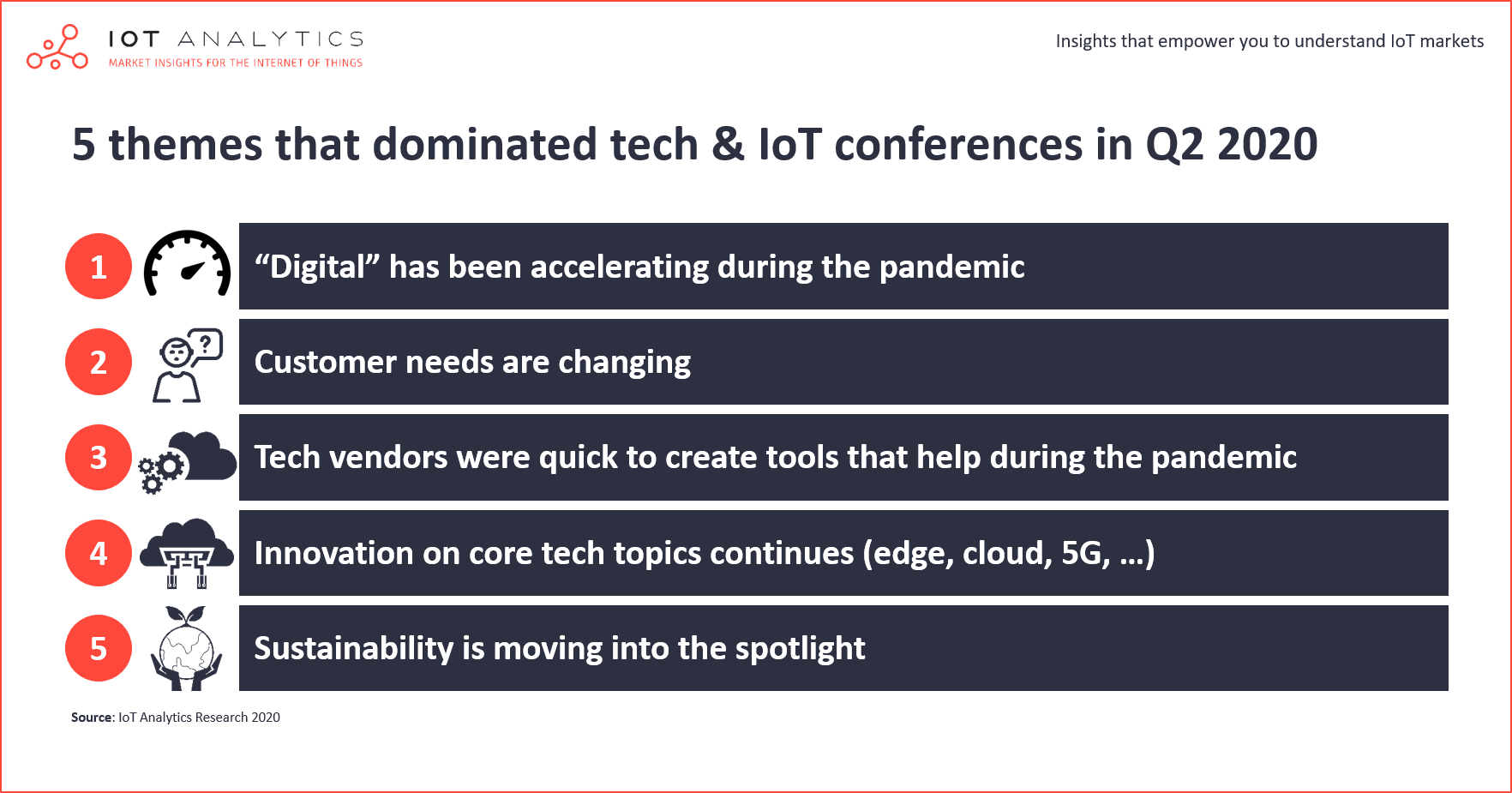The first round of virtual conferences among the Covid-19 pandemic is behind us. The IoT Analytics team attended 12 virtual conferences during the second quarter of 2020, each with a focus on the enterprise technology stack and each with some relevance for the Internet of Things.
The 12 virtual conferences attended include:
- Alibaba Cloud Summit
- AVEVA World Digital
- AWS Summit
- Microsoft Build
- Cisco Live
- Huawei Analyst Summit
- IIOT World Days
- PTC LiveWorx
- Siemens Realize Live
- Rockwell Automation ROK Live
- SAP Sapphire Reimagined
- Wirepas Go
IoT Analytics corporate research subscribers have access to the complete 50-page summary document of all conferences, titled: Technology Vendor News – Q2/2020

These are 5 of the top themes that emerged when comparing the insights gained at each of the conferences:
1. “Digital” has been accelerating during the pandemic
Tech vendors unanimously echo that adoption of many digital technologies has been accelerating. A survey presented by Oden Technologies at IIoT World showed that 71% of organizations give greater importance to digital transformation now. PTC, at their Liveworx conference, highlighted that factory collaboration tools and data security are two hot themes for them and that the migration to the cloud is accelerating. Schneider Electric and AVEVA highlighted “remote everything” as well as “digital for sustainability” as two of the themes accelerated by Covid-19.
2. Customer needs are changing.
“Covid-19 has shown companies what it means to have IT capacity as a fixed cost in P&L. A clear trend towards modernization is emerging”
Klaus Buerg, Managing Director, AWS, Germany
Siemens, at their Realize Live conferences, reported an increasing demand for rapid application development (with bookings for Siemens Mendix rising 145% yoy) as well as fast production of new products in need enabled by 3D-printing. For Schneider Electric CEO Jean-Pascal Tricoire, the new theme for customers is “resiliency”, either in terms of cost reductions (e.g., the transportation industry) or more capacity and robustness (e.g., food&beverage industry).
3. Tech vendors were quick to create tools that help during the pandemic
Many tech vendors quickly reacted to the pandemic and created tools to help customers and the public. SAP for example teamed up with Deutsche Telekom to co-develop a Corona warning app in Germany which was in use by ~20% of the German population just 3 weeks after release. Both AWS and Microsoft created a centralized database for relevant Covid data (AWS Covid data lake, Microsoft open machine readable research database). Amazon also provided support for testing and made disaster response credits available to communities who were looking for business continuity in the cloud. PTC teamed up with Ansys and Microsoft to help build Covid-19 isolation units based on their Windchill PLM software. The company also provided free access to Vuforia Chalk, a tool that leverages AR to enable remote operations, maintenance, and repair. Siemens helped some of their customers operate differently. A notable example is that of Vietnamese automobile firm Vinfast which managed to produce 55,000 ventilators in a month thanks to Siemens’ Digital Twin tools.
4. Innovation continues on core tech topics such as edge, cloud, digital twins, and next generation communication networks
Both AWS and Alibaba announced their next generation elastic compute services during Q2/2020, which are based on faster processors that promise the customer a much better price to performance ratio. Microsoft highlighted its new Azure-powered supercomputer that is particularly geared towards leveraging Artificial Intelligence at scale. Schneider Electric/AVEVA are making a push at the edge by announcing new partnerships with Lenovo and Stratus. The standout topic for Siemens is the company’s focus on no-code/low-code through its Mendix acquisition. Siemens plans to use Mendix as its platform for building new SaaS solutions (e.g., Teamcenter X). Rockwell Automation announced new edge hardware (i.e., new gateways, PLCs that run HMI software). The company also announced several deep product integrations with PTC ThingWorx (e.g., connecting Rockwell’s historian to ThingWorx). PTC, which historically had a very strong on-premise business, announced plans to eventually make all software solutions available as Software-as-a-Service in the cloud (enabled by its Atlas platform). Huawei and partners jointly launched the Fifth Generation Fixed Network (F5G) industry initiative which aims to bring the fragmented ecosystem of the fixed network industry together and promote topics such as “fiber to everywhere” (as opposed to “fiber to the home”). Cisco put a big focus on the security of its software-defined wide area network architecture (SD-WAN) which promises cheaper connectivity, faster data throughput, and more commercial flexibility.
5. Sustainability is moving into the spotlight
One of the emerging themes is a stronger focus on sustainability. SAP announced its new “Climate 21” initiative which aims to embed a number of sustainability metrics into SAP’s products with the first such module being a “Carbon Footprint Analytics” application. Both Siemens and Schneider Electric/AVEVA spent a significant amount of time at their respective conferences highlighting how their customers use their tools to build products that reduce environmental impact.
More information and further reading
The findings discussed in this article are derived from the 50-page Technology Vendor News – Q2/2020 report which includes a lot more examples and insights related to the Internet of Things.
A sample of the report can be downloaded here:
Are you interested in continued IoT coverage and updates?
Subscribe to our newsletter and follow us on LinkedIn and Twitter to stay up-to-date on the latest trends shaping the IoT markets. For complete enterprise IoT coverage with access to all of IoT Analytics’ paid content & reports including dedicated analyst time check out Enterprise subscription.
The post 5 themes that dominated tech and IoT conferences in Q2 2020 appeared first on IoT Analytics.
via https://www.aiupnow.com
by Knud Lasse Lueth, Khareem Sudlow
